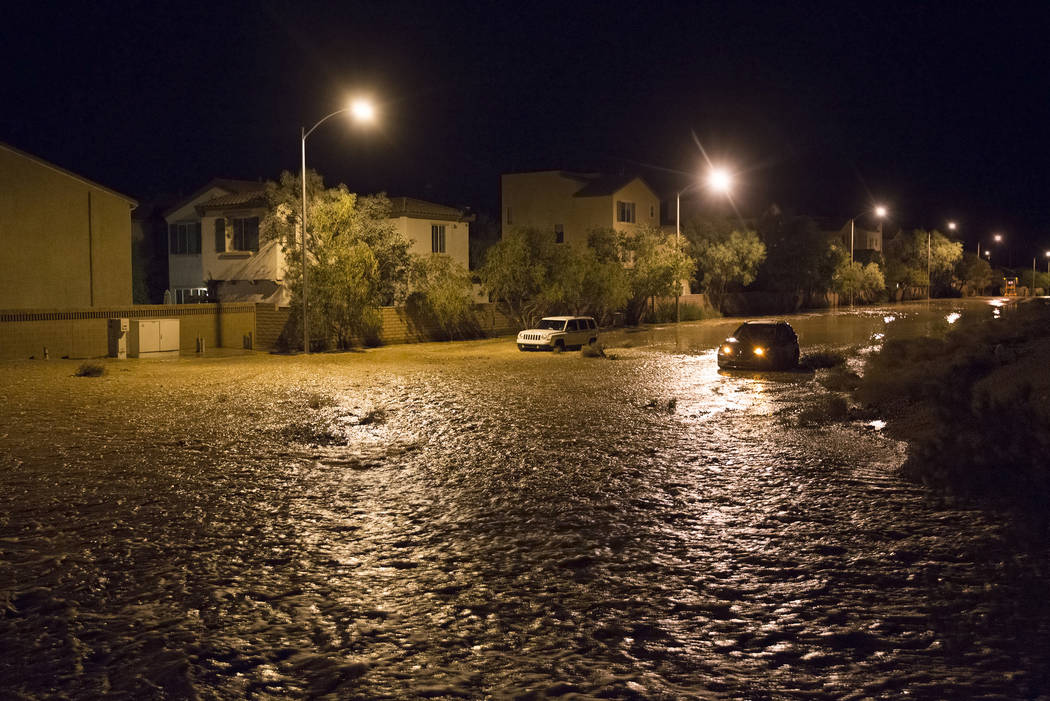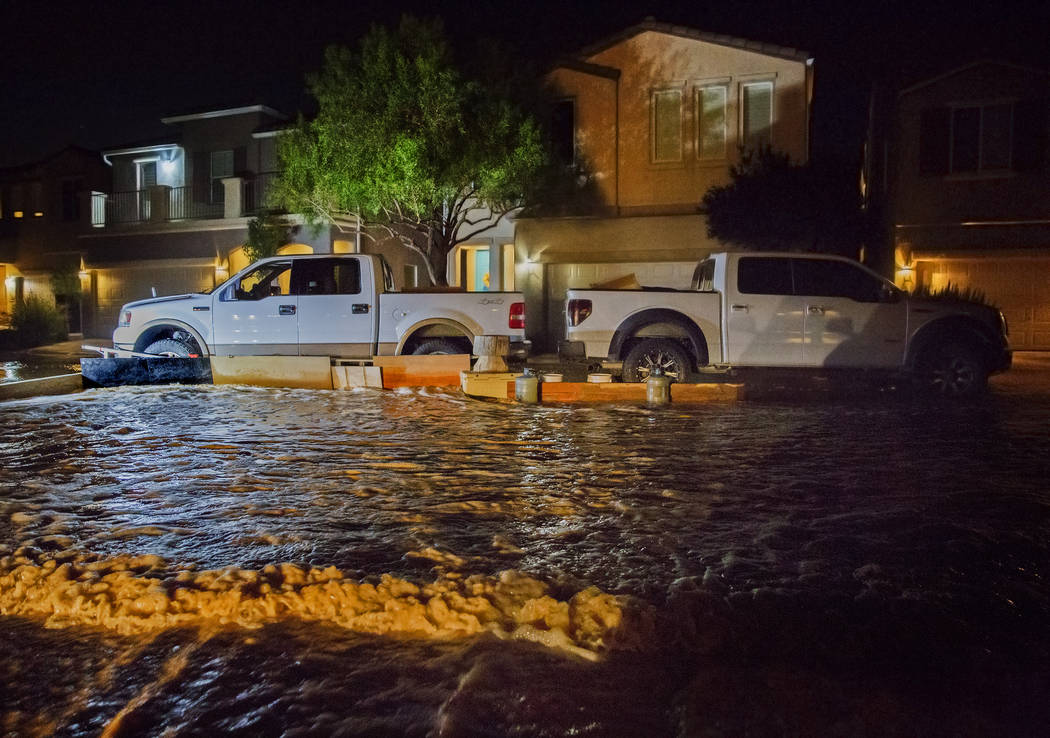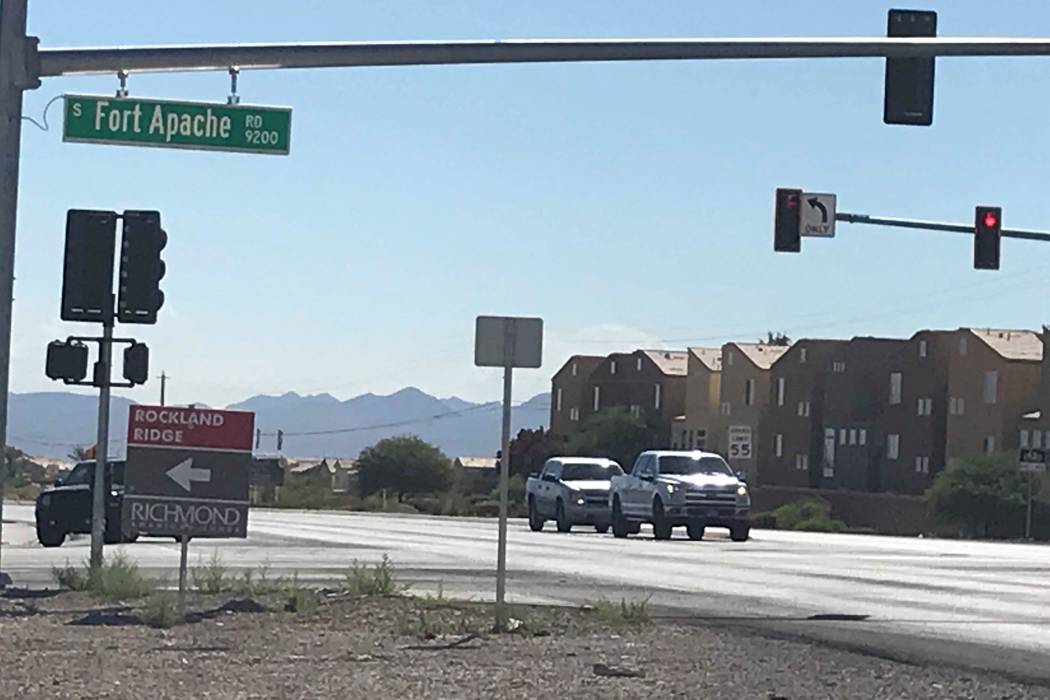Projects aimed at limiting southwest Las Vegas flooding
The Regional Flood Control District plans projects — one of which could start next year — to help alleviate flooding in southwest Las Vegas.
More than an inch of rain fell July 31, which led to flooding in some areas, including parts of Mountain’s Edge and downstream of the flood control district’s Duck Creek Railroad Detention Basin.
Residents in the southwest area of Mountain’s Edge dealt with floodwaters up to 2 feet deep.
Since its inception in 1985, the flood control district has removed about 19 square miles from flood zone designation in southwest Las Vegas through flood control projects. And it has removed 54 square miles across Clark County.
For homeowners, that means a huge cost savings. Those who aren’t in a flood zone anymore don’t have to purchase costly flood insurance.
Homeowner’s insurance typically doesn’t cover flood damage. If you have a mortgage from a federally regulated or insured lender and live in a high-risk flood area, you’re required to buy flood insurance, according to the Federal Emergency Management Agency.
“When you’re required, the rates are exceptionally high,” flood control district spokeswoman Erin Neff said.
The Legislature gave the OK in 1985 to authorize local flood control districts, including in Clark County, that address flooding and construct flood control facilities.
The local district receives funding from a one-quarter of one-cent sales tax in Clark County. For 2019, that’s expected to total roughly $105 million, Neff said.
Southwest Las Vegas projects
The flood control district plans to build a 170-acre-foot Silverado Ranch Detention Basin near Silverado Ranch Boulevard and Arville Street. District officials hope the estimated $21 million project will be funded by the end of the year, and work could start in early 2020.
“We’re still hashing out some design conflicts with the land development company (American West Homes) in the area,” Neff wrote in an Aug. 15 email to the Las Vegas Review-Journal. “Once it’s finished, the basin will bring substantial relief to that area.”
This summer, flooding affected streets — such as Jones Boulevard, Dean Martin Drive and a cul-de-sac off Le Baron Avenue south of Decatur Boulevard — downstream of the Duck Creek Railroad Detention Basin.
The district is also looking to address flooding issues in the Mountain’s Edge area, including Fitzwilliam Avenue near Fort Apache Road.
“This area flooded because a storm drain has yet to be built to carry water safely from the Upper Duck Creek Detention Basin to existing storm drain downstream,” Neff wrote.
A proposal in the district’s master plan for a storm drain that would carry water underground hasn’t been funded or designed yet.
“We’re currently in negotiations with the county and developer about how to accelerate that project,” Neff wrote.
A berm has been rebuilt above Fitzwilliam at Fort Apache.
Officials from Clark County’s Department of Public Works are meeting with the flood control district and developers “on what we can do to mitigate flooding in the area of Mountain’s Edge,” county spokeswoman Stacey Welling wrote in an email Aug. 27 to the Review-Journal.
That includes a review to see if the Duck Creek Railroad Detention Basin can be widened and if the size can be increased; designing the Silverado Ranch Detention Basin; and plans — but no timeline yet — to install drainage on Jones Boulevard, Decatur Boulevard and Cactus Avenue, Welling said.
In a written statement Aug. 29, Mountain’s Edge Master Association community manager Gary McClain said: “The concerns and issues that matter to the residents of Mountain’s Edge are of utmost importance. The seasonal monsoon our Valley experienced on July 31st, 2019 was especially intense, deluging some areas in and around Mountain’s Edge with an inch of rain in under an hour.”
Most of Mountain’s Edge experienced little impact from the flooding, McClain wrote, except those who commute using Fort Apache or take walks along community paseos, which are open flood channels.
“Most of the water that enters Mountain’s Edge makes (its) way underground into storm sewers; the rest is safely carried away in two open flood channels,” he said. “We refer to these as community paseos, as they are used and maintained as walking trails. As a reminder to all community members: while pleasant for walking on sunny days, the paseos are primarily designed to function as water runoff channels and should be avoided when rain is in the area.”
After the July 31 storm, “within a few hours, the berm was restored and the surface flooding was stopped,” McClain wrote. “Clark County Public Works sent multiple street sweepers to remove rock, soil, and debris from impacted public streets.”
Mosquitoes in the southwest
Public health officials say standing water can attract mosquitoes, some of which may carry diseases that can harm people. But it doesn’t appear the southwest has been affected more than other areas of Clark County.
The Southern Nevada Health District declared a West Nile virus outbreak in August.
Human cases aren’t broken down in reports by ZIP code due to patient privacy issues, health district spokeswoman Stephanie Bethel said. It’s also not always possible to determine where someone was bitten by an infected mosquito.
The health district has identified West Nile virus-infected mosquitoes in 40 ZIP codes, according to an Aug. 23 mosquito surveillance report. Eight southwest Las Vegas ZIP codes are affected.
Three of those southwest ZIP codes also have mosquitoes that tested positive for St. Louis encephalitis virus. They’re among 15 affected ZIP codes in Clark County.
There hasn’t been any geographic pattern with West Nile cases this year, said Vivek Raman, environmental health supervisor for the Southern Nevada Health District’s mosquito surveillance program.
In June, there was an increase of mosquitoes across the valley due to a wet spring, he said.
Monsoon season can lead to floodwater mosquitos, but the health district hasn’t received any complaints about them this year, Raman said, adding, “They tend to be in areas of our desert that can collect rainwater from those heavy monsoons.”
The good news about floodwater mosquitos, he said, is that they don’t typically carry West Nile virus.
Contact Julie Wootton-Greener at jgreener@reviewjournal.com or 702-387-2921. Follow @julieswootton on Twitter.
Infected mosquitoes in the southwest
Here’s a list of southwest Las Vegas ZIP codes with mosquitoes that tested positive, as of Aug. 23:
West Nile virus: 89107, 89146, 89102, 89113, 89118, 89139, 89178, 89141
St. Louis encephalitis virus: 89102, 89107, 89113

























